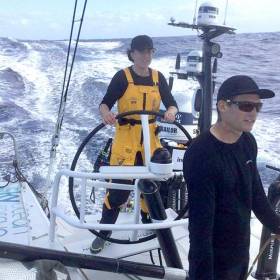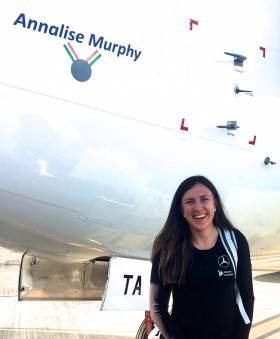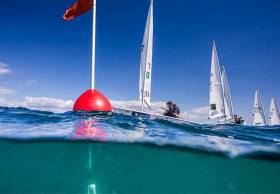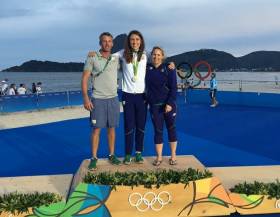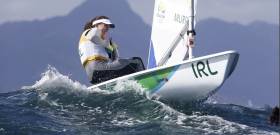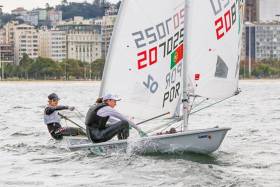Displaying items by tag: olympic sailing
Is Offshore Sailing an Olympic Possibility?
Some decisions and the sentiment expressed at World Sailing’s 2017 Conference recently suggest that the door might be opening for offshore sailing to become an Olympic sailing event.
Submission 108 presented by the World Sailing Board, and passed by the Council, greenlights the establishment of an Offshore World Championship in one-design boats. The submission gives credence to the proposal made to the International Olympic Committee to hold an Offshore “Showcase” event at the Tokyo 2020 Games.
Noboru Kobayashi of the Japanese Sailing Federation, speaking to the submission, suggested a 300 mile offshore course starting close to the Olympic Marina in Tokyo Bay and finishing in Enoshima just west of Tokyo.
While there is much detail to be discussed, it is believed that the format will allow for a two-handed, mixed gender crew sailing in supplied one-designs with the Figaro Beneteau 3 being mentioned as a potential class.
If given the go-ahead, the showcase event would likely take place immediately prior to the Games themselves, and, if deemed successful, could become a full medal event in 2024.
Tokyo 2020 Olympic Sailing Format & Qualification Decided, Olympic Berths Up For Grabs in Aarhaus
The racing format for Annalise Murphy's bid for an Olympic Gold medal has been settled at last week's World Sailing Conference in Mexico.
It will almost certainly see Ireland's Olympic Slver Medalist from the National Yacht Club in Dun Laoghaire break from her Volvo Ocean Race campaign next May to win a place for Ireland on the Laser Radial Tokyo startline at the 2018 Sailing World Championships, the principal Olympic Sailing qualification event.
The Men's and Women's 470, Finn, Laser and Laser Radial will all sail an opening series which will be followed by a double point Medal Race.
As well as Murphy, at least three other Irish Radial Sailors will seek Tokyo selection, including top performing Aoife Hopkins of Howth Yacht Club. Also campaigning is Aisling Keller of Lough Derg and Sally Bell of Belfast Lough. In the Mens Laser division, Rio rep Finn Lynch is likely to face a challenge for the single Tokyo berth by Belfast's Liam Glynn, Howth's Ewan McMahon and Royal Cork's Johnny Durcan.
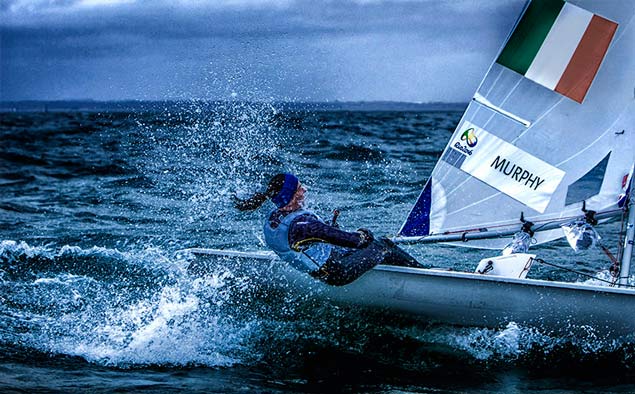 Annalise Murphy training on her beloved Dublin Bay Photo: Terry McDonagh
Annalise Murphy training on her beloved Dublin Bay Photo: Terry McDonagh
Men's and Women's RS:X sailors will also sail an opening series and a double point Medal Race, however when the wind conditions suit planing, they will have a reaching start and finish.
World Sailing's Council had a discussion and debate on the 49er and 49erFX Medal Race format. The Events Committee proposed that three single point races on the final day shall be sailed with the use of boundaries at the discretion of the Race Committee. Ireland currently has up to five 49er campaigns vying for a single Tokyo slot.
Council voted against the proposal and the 49er and 49erFX fleets will now sail an opening series and a single double points Medal Race.
The Council also noted that the Nacra 17 format had not been fully tested but it's expected they will retain their current opening series and a single double points Medal Race.
Olympic Qualification System for the Tokyo 2020 Sailing Regatta
The qualification system for Tokyo 2020 was also approved by World Sailing's Council. The Aarhus 2018 Sailing World Championships will be the principal qualification event.
Places will be available at the 2018 Asian Games, 2019 Pan-Am Games and 2019 World Championships. Further places will be available at continental events.
The qualification system will now be reviewed by the International Olympic Committee (IOC) and all International Federation qualification systems will be approved by the IOC Executive Board in February 2018.
It’s not every day you get to fly on a jetliner named in your honour writes W M Nixon. But then, not everyone has won Ireland a Silver Medal in the Olympics. Even at that, today’s busy flight schedules are so hectic that the chances of happening to fly on your personally-named plane are still slim enough.
But this weekend, everything came right for Annalise Murphy as she boarded ASL Airlines B737 “Annalise Murphy” at Dublin Airport, heading for Verona and the Moth Worlds which start on Tuesday at Malcesine on Lake Garda.
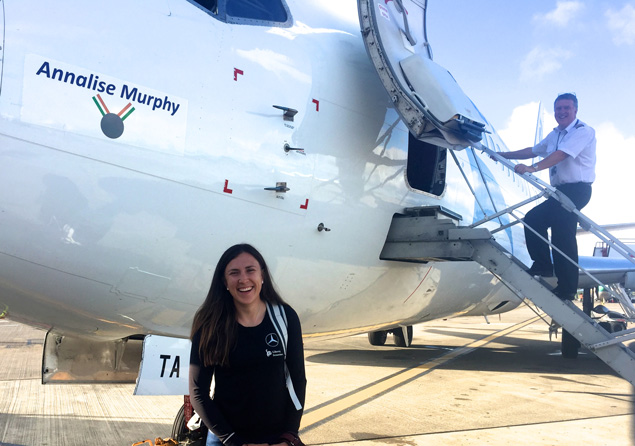 For once, she wasn’t going to be at the helm. Annalise Murphy and “her” plane as Captain Demie Ryan of Blackrock, Co Dublin goes aboard to fly her to Verona. Photo: Con Murphy
For once, she wasn’t going to be at the helm. Annalise Murphy and “her” plane as Captain Demie Ryan of Blackrock, Co Dublin goes aboard to fly her to Verona. Photo: Con Murphy
With last month’s America’s Cup and its focus on racing with foils now analysed down to the finest details, the Worlds for the foiling Moths couldn’t be staged at a more appropriate time. Several of the rock stars from the big one in Bermuda will be very much in the action on Lake Garda, including winner Peter Burling of New Zealand, and Australia’s Nathan Otteridge of the highly-rated Swedish Artemis challenge.
There are many other Olympic stars taking part in addition to Annalise, and the Irish challenge in the fleet of 240 is further strengthened by the participation of five other Irish Moth sailors, including her coach Rory Fitzpatrick, who is certainly no slouch when it comes to his own performance in foiling Moths – he emerged as champion at the Cork Dinghyfest three weeks ago. The week’s racing starts tomorrow (Monday) with the non-championship “Banging the Corner” dash-for-cash event, then after that it’s down to the serious stuff.
After some stand–out performances in the qualifying rounds of the Trofeo Princesa Sofía in Mallorca this week, Belfast Laser sailor Liam Glynn sailed in the first day of the ultra competitive Gold fleet yesterday. The former Topper World Champion has graduated to the Laser full rig having finished 29th in the Laser Radial Boys World Championships at the Royal St. George YC in Dun Laoghaire last year. He is currently 45th from 60 in gold with more races for the entire 134–boat Laser fleet today.
Equal levels of top consistency proved elusive across the two races for the Laser class, particularly among the top three sailors who all sailed one bogey result today. Spain’s emerging Grand Canaria based Joel Rodriguez is back at the top of the fleet.
The Royal Irish YC sailor Saskia Tidey from Dun Laoghaire who is now sailing with Team GB's Charlotte Dobson lies fifth in the 49erFX.
A silver fleet finish for all four Irish 49ers in Palma, Mallorca this week is a reminder of the competitiveness of the Olympic sailing circuit and the standard required to secure the single Irish berth for Tokyo in 2020. Results are here.
In the Finn class, Donaghdee's Oisin McClleland is 31st from 57.
Irish Olympic Sailing Transformed in Thirty Days
On Thursday evening, sailing came centre stage in Irish life when our new Olympic Silver Medallist Annalise Murphy was officially welcomed back to her home port of Dun Laoghaire. She arrived by sea on a summer’s evening with flags flying in abundance for a public welcome by leading local and national politicians at the landing at the East Pier, followed by a Civic Reception by the County Council in the nearby People’s Park.
Then came the ultimate celebration - the home-coming party to outshine all parties - by Ireland’s sailing community. It was at her sailing home, the National Yacht Club, where she has been a member since she was six years old. There were more than 2,000 well-wishers from all over Ireland in the crowd packed into the clubhouse and onto its balcony and forecourt. Somewhere in the midst of them was Afloat.ie’s W M Nixon, savouring the flavour of an extraordinary gathering.
It’s not the first time that Dublin Bay Sailing Club has re-arranged its regular sailing programme in order to facilitate the return to Ireland of a sailing superstar. But having missed out on the previous one back on Saturday June 20th 1925, when Conor O’Brien returned to what he sensibly called Dunleary with his 42ft Saoirse after his pioneering two year voyage round the world south of the Great Capes, we weren’t going to miss Thursday August 25th 2016 at the National YC to welcome back Annalise Murphy with her Silver Medal.
Particularly not after Dublin Bay SC Commodore Chris Moore had announced some days previously that he was going to move the formerly completely sacrosanct Thursday evening cruiser-racing weekly fixture to Wednesday, in order to clear the decks for the Annalise welcome. That was one very clearcut statement.
But before we get carried away by the great doings of last Thursday night, let us admit that back in 1925 they could also lay on the razzmatazz big-time when they’d a mind to do so. O’Brien’s circumnavigation with the Saoirse was the first notable voyage by a vessel flying the tricolour ensign of the new Irish Free State. It was a mighty venture which pioneered the traversing of the great Southern Ocean in such spectacular style with so much popular interest that when he returned, it was to find that Dublin Bay SC had cancelled their regular Saturday race in his honour.
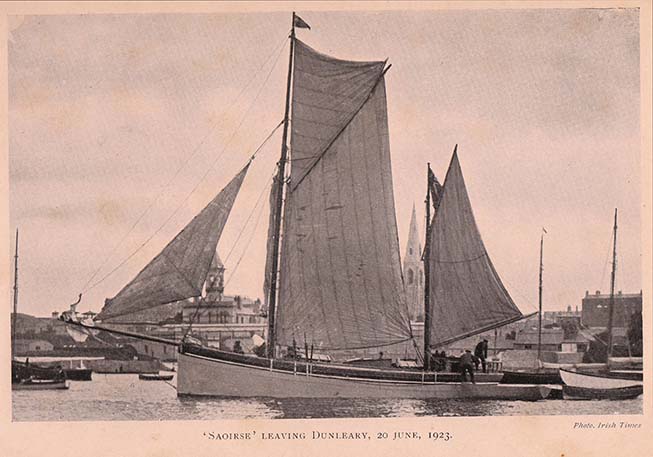 Conor O’Brien’s Saoirse departs Dun Laoghaire on 20th June 1923 on her round the world voyage south of the Great Capes. Whe she returned on Saturday June 20th 1925, Dublin Bay SC cancelled Saturday racing so that the fleet could give Saoirse a special welcome home
Conor O’Brien’s Saoirse departs Dun Laoghaire on 20th June 1923 on her round the world voyage south of the Great Capes. Whe she returned on Saturday June 20th 1925, Dublin Bay SC cancelled Saturday racing so that the fleet could give Saoirse a special welcome home
This was to enable their fleet - many colourfully dressed overall in their best signal flags – to welcome Saoirse into port. But when he finally got ashore, there was a ceremonial procession all the way into Dublin watched by notable crowds, followed by a Gala Dinner at the United Arts Club of which he, as an architect and brother of the artist Dermod O’Brien, had been a founder member.
These days, the fact that Dun Laoghaire is so vigorously the capital of Irish sailing, and so much of an urban centre in its own right, makes the notion of moving on into Dublin for the focus of any home-coming celebration of a seaborn achiever seem absurd. Despite the sometimes fractious interfaces which arise between the various bodies involved with the harbour, the fact is that Dun Laoghaire is gradually developing the facilities of a major leisure port. Thus it has absolutely everything you need within the waterfront/harbour area for a series of events like Thursday’s complex programme, which for total devotees started around 5.30pm and was still going strong at midnight.
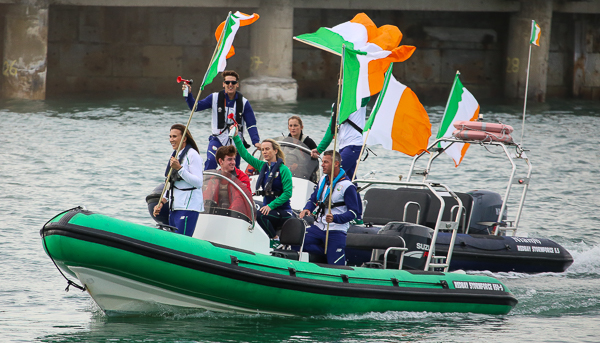 Flags and more flags – the Silver Medallist makes her return to Dun Laoghaire
Flags and more flags – the Silver Medallist makes her return to Dun Laoghaire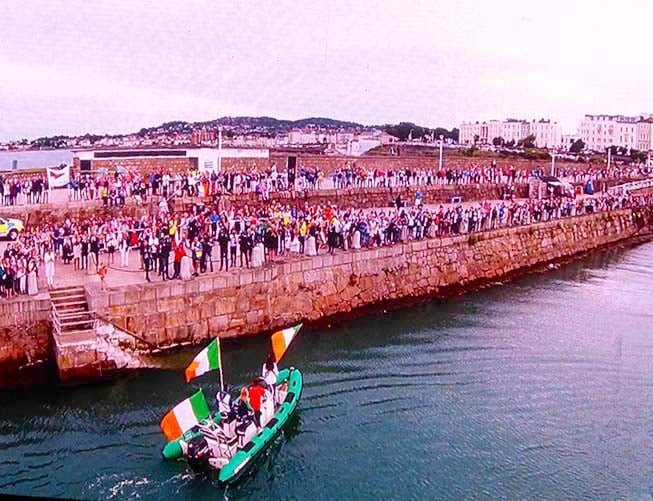
The only extra that had been required beforehand was co-operation from the weather, and even that was forthcoming despite this poor summer. We’d a clear gentle evening when in theory you could move comfortably between indoors and out. But the reality was the crowd was on such a scale (I’d reckon there were many more than 2,000) that once you found a comfortable berth, you stayed put, and just enjoyed it all as proceedings unfolded.
Admittedly when you’re celebrating success at this level after a 36 year drought since the previous Irish Olympic sailing medal, any critical faculties will be decidedly muted, but everyone in my area agreed the whole programme went very well indeed. The waterborne parade in the harbour – choreographed by Dun Laoghaire lifeboat cox’n and RIYC Marine Manager Mark McGibney – went with such style you assumed it had been rehearsed, but apparently it hadn’t. Equally there was no chance of any rehearsal for the succession of shoreside events but they all held together, and the final intensive presentation in the National YC forecourt as night drew on was pure magic, rounded out by a fireworks display.

The word is that somewhere in the background pulling the strings was Mr Fixit, Irish sailing’s invisible man Brian Craig, who is our greatest practitioner of the secret art of doing good work by stealth. Glimpsed in the crowd a couple of times, he didn’t look like someone who had the organisational problems of a major event on his shoulders. But then, he always looks like that.
Another rising star is Annalise’s brother Finn Murphy, who is so up to speed with the latest technology that he’s inventing it as he goes along. Naturally, as the public face of the National Yacht Club, Commodore Larry Power expressed concern that everything would be okay in the very hectic few days of buildup. But Finn simply told him not to worry, it would be all right on the night, and so it was.
Irish sailing did itself proud for an attendance which included 1956 Olympic Gold Medallist Ronnie Delany, Silver Medallist Sonia O’Sullivan, and our own David Wilkins who won the Silver in the Flying Dutchman in 1980. But perhaps the most memorable thing about the evening was the universality of the event. Club sailors from all over felt the urge to join with the National Yacht Club in marking this historic high in its busy life, and the mutual goodwill was tangible in the gathering dusk among the friendly crowd.
Of course, nobody denies that getting within shouting distance of a first Silver Medal is bound to involved stressful episodes, but those were receding into the forgotten past by the time Annalise and her support team got themselves on stage. She’d last made an official appearance at that pre-Olympics press conference in Dublin on Tuesday July 26th, when (see recent blog) it was quite clear that the new-look Annalise Murphy was very different from the frustrated sailor whose campaign had lost its way at the Worlds on May 20th.
But here we now were, only three months after that low point in late May, and only thirty days since that re-born vision on July 26th. Here we were, gazing in some wonder at a real live Silver Medallist, one who had controlled the final Medals Race with such competent and confident style that she moved from merely hanging onto to her Bronze Medal into a clearcut Silver Medal win.
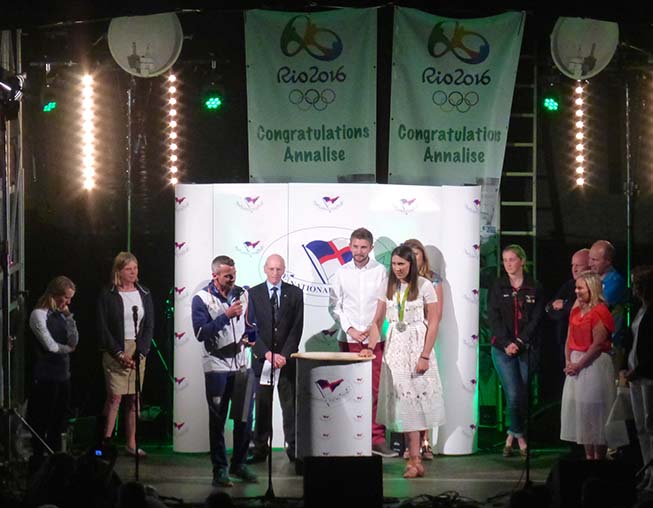
It was something which deserved celebration for everyone involved, and it was a very inclusive gathering. For an Irish sailing crowd, it seemed the most natural thing in the world that the returning Murphy family and support team should have come home from Rio bringing with them the New Zealand sailor Sarah Winther. She’d failed by one place at the Worlds to secure the New Zealand qualifying position for the Olympics, such that New Zealand didn’t send a representative in the Women’s Laser Radials at all. So the frustrated Winther then reckoned her talents might be of some use to her friend Annalise Murphy, and as she’s a natural coach and perfect training partner, she brought to Annalise and her coach Rory Fitzpatrick a new dimension for the final countdown, which made a significant difference.
So while Annalise was made an Honorary Life Member of the NYC at Thursday’s gathering, Sara Winther – who’s still a bit surprised to find herself having an unexpected holiday in Ireland in the first place – became an Honorary Foreign Member, which will have heraldry experts scratching their heads, but we all know what it means.
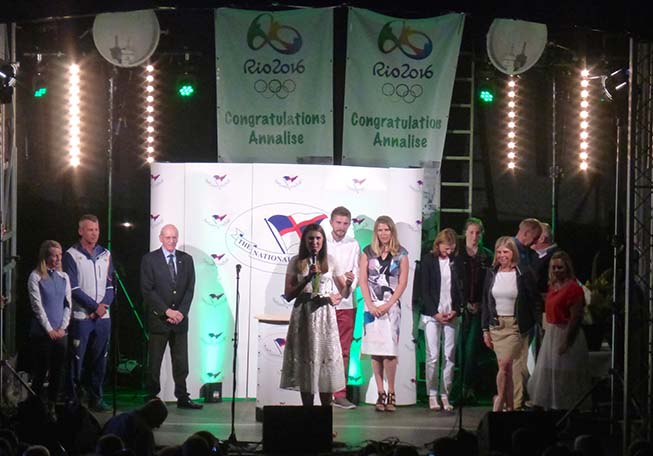
Every speech was right on target, with charming turns from Annalise and her family, a particularly good one from Rory Fitzpatrick, and a well-judged and encouraging one from Colm Barrington about where the Irish Olympic sailing effort can hope to go from here.
We’ll soon have the time and space to analyse them in detail, and having seen how much the extra effort Annalise Murphy put into getting to know the tricky sailing waters of Rio beforehand, and how much it contributed to her success, we’ve already been looking at the little Japanese island resort of Enoshima south of Tokyo where the 2020 Olympics will be held.
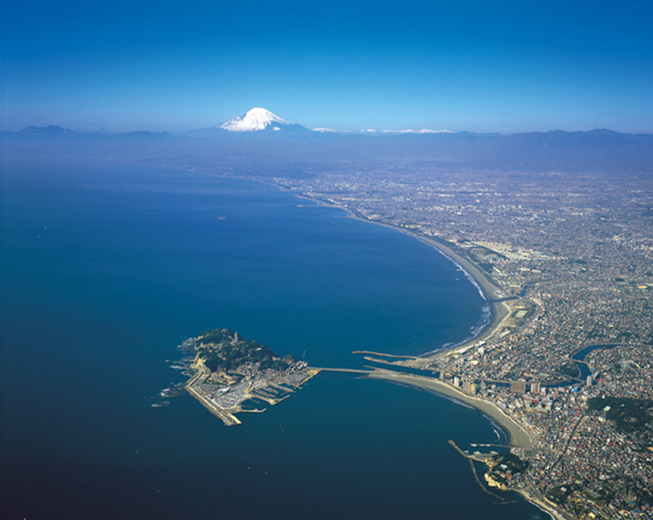 The little resort island of Enoshima on Sagamai Bay south of Tokyo is the venue for the 2020 Olympics. And yes, that is Mount Fuji in the distance
The little resort island of Enoshima on Sagamai Bay south of Tokyo is the venue for the 2020 Olympics. And yes, that is Mount Fuji in the distance
But as the Annalise Murphy success has in its way contributed a textbook of how to put together and Olympic campaign and then bring it back on course when things go astray, we can be quite sure that all over the world, other people will be studying just how Ireland won this particular silver.
And as for repeating strategies which were successful in Rio, we have to remember that Japan is very different from Brazil. In Rio the Olympic authorities may not have objected to the fact that Annalise and her team preferred to set up their own base away from the barely-finished Olympic village, in an apartment convenient to the sailing area, and with facilities where they could control their food. But in the more disciplined world of Japan, it mightn’t be allowed.
However, that’s another day’s work. Let us conclude on another note entirely. In the many vox pop interviews on the media, people have been enthusing about what a marvellous role model and inspiration Annalise Murphy has become for Ireland’s young sailors. But surely that’s only partially true? Here at Sailing on Saturdays HQ, we reckon Annalise Murphy has become a marvellous role model and inspiration for all Ireland’s sailors.
Annalise's homecoming photo gallery by Joe Fallon
Turning Rio Result Into Tangible Benefit for Sailing in Ireland
While Irish Sailing is rightfully basking in the reflected glory of last night's homecoming celebrations for Annalise Murphy and its Olympic Sailing Team there will also be one eye to the future, considering how to turn the positive Rio results into tangible benefits for the development of sailing in Ireland, not just in High Performance, but across every aspect of the sport.
There is no doubt that, in the modern sports world, medals mean money. An analysis of Sports funding in many developed countries shows that successful sports benefit from good results at World Championships and major Games.
In Atlanta in 1996, Britain finished 26th in the medal table (Ireland was 16th – entirely due to Michelle Smith) with a total of 15 medals from six sports. The improvement over the five intervening Olympiads to the 67 medals from 22 sports in Rio, is due to a variety of things, but perhaps most of all to the increased investment in sport aided by the introduction of the National Lottery. Sports with a plan, that medalled in Atlanta, benefitted the most, while the ones that lagged behind were given a boost by the increased investment occasioned by being the host nation for the 2012 games.
Sailing in the UK received £25.5m in the Rio Olympic cycle, the fourth highest funded sport after Athletics, Swimming and Cycling. Sailing in Ireland received €2.545m in High Performance funding, third place after Boxing and Athletics (figures exclude paralympic sports). It might also be argued that Ireland did better in terms of the cost per medal – the Irish Sailing silver medal cost €2.545m, while Britain's 3 sailing medals cost £8.5m each.
David O'Brien reports in the Irish Times that as Sport Ireland looks to fund the Tokyo 2020 squad, there is no doubt that Sailing and Rowing will enter the negotiations with the considerable clout that medals bring, but there will be a more forensic analysis of what led to success and whether the sport has a pipeline that will lead to sustainability of results on the international stage.
The ISA will be able to point to the potential shown in Rio as well as an impressive track record by ISA academy members at Youth Sailing Worlds and World and European Championships. There have been many significant results, not least World Youth Sailing bronze in the 420 in January and as recently as July, World Youth Silver in the Laser Radial.
Also under scrutiny, particularly in light of recent developments, will be whether the sport has robust governance, ensuring fairness and transparency, as well as a willingness to engage with the Irish Institute of Sport, an arm of Sport Ireland that played a leading role in the success in Rio. Irish Sailing passes these test as well, putting it in a very strong position to negotiate vigorously, not only for High Performance, but also for investment into the grassroots of the sport.
Click for more on last night's spectacular Olympic homecoming celebration on Afloat.ie
Annalise Murphy Sends Thanks from Rio for 'Amazing Support'
The National Yacht Club sailor, Annalise Murphy from Dun Laoghaire, who overcame heartbreak in London 2012 to take a silver medal in Rio on Tuesday has been thanking suporters via her Facebook page. In a typical warm but modest fashion the Olympic silver medallist says: 'Wow I don't really know what to say! This is a dream come true, not only for me but for everyone who has helped me get to this point over the last 8 years! Thank you everyone for all the amazing support, it means the world to me! Still in shock but so proud to be Irish! X Annalise'.
She is pictured on the podium with her coaches Rory Fitzpatrick and Sara Winthers who she credits with so much of her success.
Annalise Murphy's journey has been charted in a unique photo review by the Irish Times this morning here
Her road to silver success was profiled in the newspaper yesterday by correspondent David O'Brien here.
Annalise Murphy's Medal Race Postponed, First No Wind Then Too Much
After a frustrating wait for wind on the Sugarloaf course in Rio today, Annalise Murphy and the other nine medal race competitors went afloat only to have racing scrubbed when strong winds swept over the course. The racing was postponed and will resume tomorrow.
GBR Giles Scott Assured Finn Gold With a Race to Spare
Giles Scott (GBR) has assured himself of gold after another brilliant performance that leaves him 24 points clear at the top after the fifth day of racing at the Rio 2016 Olympic Sailing Competition. Vasilij Zbogar (SLO) is second, 13 points ahead of Ivan Kljakovic Gaspic (CRO). Once again, Rio’s challenging conditions provided a mixed bag of results, with several sailors picking up high scores. There is now just the medal race to sail.
With no clear form through the fleet apart from Scott and Zbogar, it was always going to be a scrap to the finish, with the points around the medal race cut off very, very close. For the fifth day in a row it was all change once again.
After a long postponement, first ashore and then afloat to wait for the wind, Kljakovic Gaspic started his day leading round the top mark in race 9, in very light winds. He was passed on the second upwind by race 1 winner, Facundo Olezza (ARG), who maintained the lead, by mere seconds, all the way to the finish. Alejandro Foglia (URU), who had rounded the top mark in 15th, finally found his speed to cross in third.
Foglia then went on to win Race 10, started in slightly more wind, after overtaking Scott on the final downwind. Caleb Paine (USA) had rounded first but dropped to fourth while Ioannis Mitakis (GRE) ended the race where he started, in third.
To make sure of the gold today, Scott had to gain three points on Zbogar. In the first race of day, he looked to have opened out a nice margin, only to loose ground on the second upwind and finish just one place ahead. But the margin had increased to 18 points and most of his other rivals had high scores.
So in the final race, Scott just had to finish more than two boats ahead of Zbogar to win the gold with a race to spare. For a while Zbogar was right behind Scott, but a few errors on the second upwind let Scott escape, and the gold was gone.
Meanwhile Olezza followed up his race win with a seventh to climb back in to the top 10 again. A last place for Jake Lilley (AUS) in race 9 initially dropped him out of the medal race, after going into the day in third, but after Pieter-Jan Postma (NED) was disqualified from race 10, Lilley gains one point to overtake Ioannis Mitakis (GRE), and was back in the medal race.
In addition, both Paine and Max Salminen (SWE) have closed on the top and are now within striking distance of the podium.
Asked what it meant to him to win the Olympic title, a normally unemotional Scott said, “I know what it meant to me because of the way it made me feel towards the last stages of that final race. I just found myself welling up and in tingles as it slowly dawned on me what I'd done. I wouldn't put myself down as the emotional sort but I had a little cry to myself, which I like to think I don't do that often. Just the emotions that come out of you in that situation you can't prepare yourself for. It's been amazing.”
"When we put the campaign together after London, Matt [Howard], my coach and I we decided that we wanted to campaign flat out. We weren't going to go soft in any regattas and everything we went to, we wanted to win and win it in style.”
"That approach is great but it does put a target on your back. Especially two or three years out that target inevitably gets closer as everybody ups their game. To have been able to maintain that gap enough into the Olympics with a race to spare - it gives great justification to those decisions earlier on.”
A clearly exhausted Zbogar commented, “It was a really difficult day, really stressful because the wind was up and down. Puffs of wind were all over the race area and it was impossible to predict, so very tough mentally. I tried to be conservative playing the middle, and I lost a few places there in both races. But at the end I think I managed to have two good races, which was really good in these conditions.”
“In the first race if there were not the big waves, it would have been easy sailable, but the waves made it almost impossible. It was up and down and was a bit of a lottery at the end. And many guys were ahead and in a few moments lost everything.”
Foe the first time in the regatta, Kljakovic Gaspic has moved into a podium position. “The first race was quite light, but for me was regular. There were big differences in the downwind in pressure and positions so it was not easy to sail. I was lucky being extended on the front so I didn’t have this headache, but for other guys it was quite tough.”
“The second one was tragic for me. I was just getting extra points for nothing and making my life more complicated that it should have been. Right from the start everything started to get complicated and when racing gets complicated it’s never good. And then the wind picked up and distances got that much bigger and it got harder to recover. On the second beat I went on the left side to get more pressure and it didn’t come, and lost even more places.” He finished 13th.
“But at the end of the day I am still in a good position. I need to sleep and relax and get ready for Tuesday.”
Scott still must sail the medal race, but the result is irrelevant. He cannot be beaten. Mathematically, any boat in the top 10 can win a medal, but that would need some letter scores. Zbogar is almost secure for a medal. To lose a medal, he would have to be last, with Paine or Max Salminen (SWE) winning. Kljakovic Gaspic in third, is just five points ahead of Paine and Salminen, so the question is will he attack for silver or try to defend the bronze?
The medal race is scheduled for 13.05 on Tuesday 16 July. It might even be on TV, if you are lucky.
Irish Olympic Sailing Team Profiles for Rio
The chances of winning an Olympic sailing medal next month, have been described by Team manager James O'Callaghan as an 'outside shot'. Can Ireland's four boat Irish Olympic Sailing Team deliver on the 36–year medal drought? Afloat.ie gives its assessment boat by boat
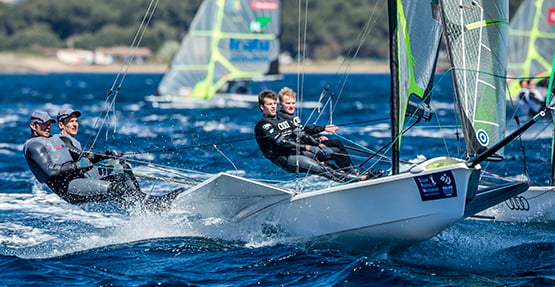 Belfast Lough's Ryan Seaton and Matt McGovern start racing in Rio on August 12
Belfast Lough's Ryan Seaton and Matt McGovern start racing in Rio on August 12
49er – Ryan Seaton & Matt McGovern
Ryan Seaton and Matthew McGovern have been steadily working their way up the world rankings this year, from 22ncd at the start of the year to 11th in the latest version. These London 2012 veterans (14th) have put in some stellar performances in recent months, most notably winning the Princesa Sofia Regatta in Palma in April.
Seaton and McGovern qualified Ireland at the first possible opportunity at the combined World Championships in Santander in 2014, finishing 8th. But their performance since has been erratic and the win in Palma was bookended by a 37th in Miami and a 28th at the 2016 Europeans. Most recently, at the international sailing week in Rio, the Belfast pair finished down the fleet, but may have been using this regatta for testing or training purposes.
There is no doubt, that on their day, Seaton and McGovern can compete with the world's best.
Men’s Skiff (49er) 20 competitors Race duration: 3 x 30 minutes daily (medal race 1 x 20 minutes) Competition days: Fri 12th/Sat 13th/Sun 14th (Reserve)/Mon 15th/Tue 16th/Wed 17th (Reserve)/Thu 18th - medal race/Fri 19th (Reserve)
 Dublin Bay's Andrea Brewster and Saskia Tidey start racing in Rio on August 12
Dublin Bay's Andrea Brewster and Saskia Tidey start racing in Rio on August 12
49erFx – Andrea Brewster & Saskia Tidey
Andrea Brewster and Saskia Tidey were the last of the Irish team to qualify, enduring heartbreak at the 2015 worlds where they were denied qualification by a protest in the final race report here. However, their performance at the Worlds was good enough to secure the next available place a few months later when no team from Africa emerged. Story here.
Brewster, a product of the British Olympic Laser radial squad, and Tidey, who transitioned from the Radial to the 49er following a season racing 18ft Skiffs in Sydney, have, until this year, hovered in the early 20s in world ranking and results at major events. 2016 has been something of a breakthrough for the Royal Irish duo, finishing in the teens more consistently, including a 12th at the European championships in Barcelona in April. A final day scoreline of 2,1,3 shows the potential that resides in this team.
Women’s Skiff (49erFX) 20 competitors Race duration: 3 x 30 minutes daily (medal race 1 x 20 minutes) Competition days: Fri 12th/Sat 13th/Sun 14th (Reserve)/Mon 15th/Tue 16th/Wed 17th (Reserve)/Thu 18th - medal race/Fri 19th (Reserve)
 Dublin Bay's Finn Lynch starts racing in Rio on August 8
Dublin Bay's Finn Lynch starts racing in Rio on August 8
Laser – Finn Lynch
Finn Lynch's fairytale journey to Rio is recounted in Sailing on Saturdays by Winkie Nixon. However he had to overcome the 2012 Olympian James Espey, who's 38th place at the 2014 world Championship in Santander qualified the country. ISA imposed a three regatta trials system, starting with the Copa de Brasil regatta in Rio in December 2015, where Espey shaded Lynch by one place. At the next event in Palma in March and April, neither sailor made gold fleet, but Espey increased his advantage with a 53rd to Lynch's 58th. Going into the final trial, the 2016 Laser Worlds in Mexico in May, Lynch had it all to do, but a solid series of consistent results saw him qualify for the Gold Fleet, while Espey never really got off the ground until it was too late.
While Lynch, who's best results have been at under age events, is certainly not a favourite for podium in Rio, his trajectory suggests that a medal in Tokyo in 2020 is well within his capability.
Men’s One-person dinghy (Laser) 46 competitors Race duration: 2 x 50 minutes daily (medal race 1 x 25 minutes) Competition days: Mon 8th/Tue 9th/Wed 10th/Thu 11th (Reserve day)/Fri 12th/Sat 13th/Sun 14th (Reserve)/Mon 15th - medal race/Tue 16th (Reserve)
 Dublin Bay's Annalise Murphy starts racing in Rio on August 8
Dublin Bay's Annalise Murphy starts racing in Rio on August 8
Laser Radial – Annalise Murphy
Currently perhaps Ireland's most famous sailor, Annalise Murphy dismissed the challenge of Aoife Hopkins in the three event trial. However, recent form contradicts her suggestion that she is one of eight in the fleet with the potential to win a medal in Rio. Since January, her results at major events have been 48th (Miami World Cup), 30th (Laser Europeans), 39th (Laser Worlds) and 34th (Weymouth World Cup). The historical profile of light and fickle winds at the Olympic venue suggests that Annalise, a heavy weather specialist, will struggle to make the medal race. The 2013 European champion has, however, surprised on many occasions before and as recently as this month scored an important win on Olympic waters in her last regatta before the Games at the Rio de Janeiro International Sailing Week. Results of that win are here.
Women’s One-person dinghy (Laser Radial) 37 competitors Race duration: 2 x 50 minutes daily (medal race 1 x 25 minutes) Competition days: Mon 8th/Tue 9th/Wed 10th/Thu 11th (Reserve day)/Fri 12th/Sat 13th/Sun 14th (Reserve)/Mon 15th - medal race/Tue 16th (Reserve)
Afloat.ie has charted the progress of the 2016 Olympic sailing team over the last four years in a dedicated Irish Olympic Sailing section




























